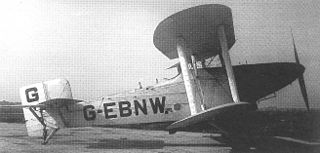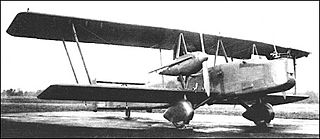Related Research Articles

The Avro 679 Manchester was a British twin-engine medium bomber developed and manufactured by the Avro aircraft company in the United Kingdom. While not being built in great numbers, it was the forerunner of the famed and vastly more successful four-engined Avro Lancaster, which would become one of the most capable strategic bombers of the Second World War.

The Handley Page Halifax is a British Royal Air Force (RAF) four-engined heavy bomber of the Second World War. It was developed by Handley Page to the same specification as the contemporary twin-engine Avro Manchester.

The Vickers Warwick was a multi-purpose twin-engined British aircraft developed and operated during the Second World War. In line with the naming convention followed by other RAF heavy bombers of the era, it was named after a British city or town, in this case Warwick. The Warwick was the largest British twin-engined aircraft to see use during the Second World War.

The Fairey Fox was a British light bomber and fighter biplane of the 1920s and 1930s. It was originally produced in Britain for the RAF, but continued in production and use in Belgium long after it was retired in Britain.

The Vickers Vildebeest and the similar Vickers Vincent were two very large two- to three-seat single-engined British biplanes designed and built by Vickers and used as light bombers, torpedo bombers and in army cooperation roles. First flown in 1928, it remained in service at the start of the Second World War, with the last Vildebeests flying against Japanese forces over Singapore and Java in 1942.

The Handley Page Heyford was a twin-engine British biplane bomber of the 1930s. Although it had a short service life, it equipped several squadrons of the RAF as one of the most important British bombers of the mid-1930s, and was the last biplane heavy bomber to serve with the RAF. The aircraft was named after and first deployed at RAF Upper Heyford, near Bicester in Oxfordshire.

The Vickers Windsor was a Second World War British four-engine heavy bomber, designed by Barnes Wallis and Rex Pierson at the Vickers-Armstrongs factory at Brooklands.

The Vickers Virginia was a biplane heavy bomber of the British Royal Air Force, developed from the Vickers Vimy.

The Fairey Hendon was a British monoplane, heavy bomber of the Royal Air Force, designed by Fairey Aviation in the late 1920s, which served in small numbers with one Squadron of the RAF between 1936 and 1939. It was the first all-metal low-wing monoplane to enter service with the RAF.

The Avro 549 Aldershot was a British single-engined bomber aircraft built by Avro.

The Armstrong Whitworth Awana was a British prototype troop-transport aircraft built to meet a 1920 Air Ministry requirement.

The Fairey Fawn was a British single-engine light bomber of the 1920s. It was designed as a replacement for the Airco DH.9A and served with the Royal Air Force between 1924 and 1929.

The Avro 571 Buffalo was a prototype British carrier-based torpedo bomber biplane, designed and built by Avro in the 1920s. It was not selected for service, the Blackburn Ripon being ordered instead.

The Avro 604 Antelope was a British light bomber which was designed and built in the late 1920s to meet a requirement for a light bomber to equip the Royal Air Force, competing against the Hawker Hart and the Fairey Fox II. It was unsuccessful, the Hart being preferred.

The Handley Page H.P.24 Hyderabad was a British twin-engine biplane heavy bomber built by Handley Page which served with the Royal Air Force between 1925 and 1933. It was the last wooden heavy bomber to serve with the RAF.

The Blackburn B-3 was a prototype British torpedo bomber designed and built by Blackburn Aircraft as a potential replacement for the Ripon. It was unsuccessful, with only the two prototypes being built.

The Vickers Vanox was a British biplane bomber design intended as a successor to the Virginia for the Royal Air Force. Although it underwent extensive development, it was not successful, only a single aircraft being built.
The Supermarine B.12/36 was a British prototype four-engine heavy bomber design that was destroyed by enemy action before completion during the Second World War.

The Parnall G.4/31 was a 1930s design from the George Parnall and Company to meet Air Ministry Specification G.4/31 for a "general purpose" aircraft.
References
- Notes
- Bibliography
- Meekcoms, K J; Morgan, E B (1994). The British Aircraft Specification File. Tonbridge, Kent, England: Air-Britain. ISBN 0 85130 220 3.